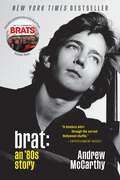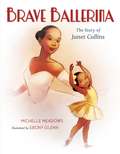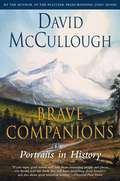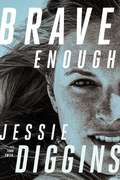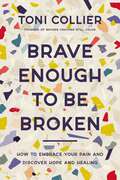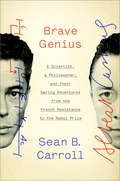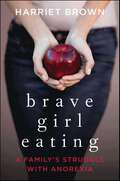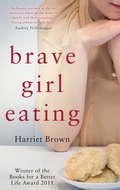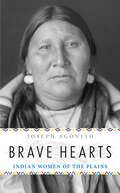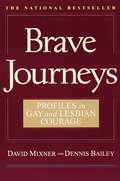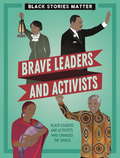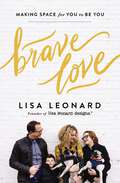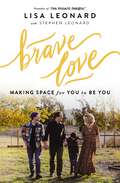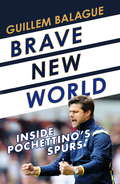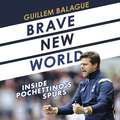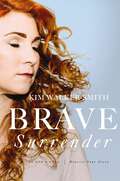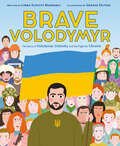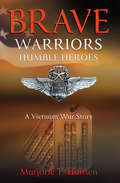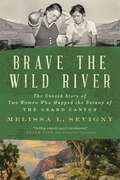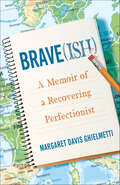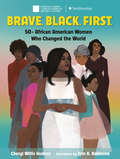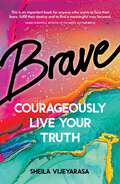- Table View
- List View
Brat: An '80s Story
by Andrew McCarthyFans of Patti Smith's Just Kids and Rob Lowe's Stories I Only Tell My Friends will love this beautifully written, entertaining, and emotionally honest memoir by an actor, director, and author who found his start as an 80s Brat pack member -- the inspiration for the Hulu documentary Brats, written and directed by Andrew McCarthy. Most people know Andrew McCarthy from his movie roles in Pretty in Pink, St. Elmo's Fire, Weekend at Bernie's, and Less than Zero, and as a charter member of Hollywood's Brat Pack. That iconic group of ingenues and heartthrobs included Rob Lowe, Molly Ringwald, Emilio Estevez, and Demi Moore, and has come to represent both a genre of film and an era of pop culture. In his memoir Brat: An '80s Story, McCarthy focuses his gaze on that singular moment in time. The result is a revealing look at coming of age in a maelstrom, reckoning with conflicted ambition, innocence, addiction, and masculinity. New York City of the 1980s is brought to vivid life in these pages, from scoring loose joints in Washington Square Park to skipping school in favor of the dark revival houses of the Village where he fell in love with the movies that would change his life. Filled with personal revelations of innocence lost to heady days in Hollywood with John Hughes and an iconic cast of characters, Brat is a surprising and intimate story of an outsider caught up in a most unwitting success.
Brave Ballerina: The Story of Janet Collins (Who Did It First?)
by Michelle MeadowsA lyrical picture book biography of Janet Collins, the first African American principal dancer at the Metropolitan Opera House. Janet Collins wanted to be a ballerina in the 1930s and 40s, a time when racial segregation was widespread in the United States. Janet pursued dance with a passion, despite being rejected from discriminatory dance schools. When she was accepted into the Ballet Russe de Monte Carlo as a teenager on the condition that she paint her skin white for performances, Janet refused. She continued to go after her dreams, never compromising her values along the way. From her early childhood lessons to the height of her success as the first African American prima ballerina in the Metropolitan Opera, Brave Ballerina is the story of a remarkable pioneer as told by Michelle Meadows, with fantastic illustrations from Ebony Glenn.
Brave Clara Barton (Step into Reading)
by Frank MurphyA Step 3 beginning-reader biography of Civil War nurse and founder of the American Red Cross Clara Barton!Meet a woman who outgrew her girhood shyness to became a fearless "Angel of the Battlefield"! This Step 3 biography follows Clara as she helps her brother recover from a terrible injury, overcomes her timidity and works as a teacher, and finally fights her way to the front lines of the Civil War, where she helps soldiers wounded in battle. Clara's story is a testament to the strength and grit of women, and is a role model who trancends history. Sarah Green's lovely and delicate illustrations render Clara's life in an appropriate and approachable way for young readers.Step 3 Readers feature engaging characters in easy-to-follow plots about popular topics. For children who are ready to read on their own.
Brave Companions: Portraits In History
by David McCulloughFrom Alexander von Humboldt to Charles and Anne Lindbergh, these are stories of people of great vision and daring whose achievements continue to inspire us today, brilliantly told by master historian David McCullough.The bestselling author of Truman and John Adams, David McCullough has written profiles of exceptional men and women past and present who have not only shaped the course of history or changed how we see the world but whose stories express much that is timeless about the human condition. Here are Alexander von Humboldt, whose epic explorations of South America surpassed the Lewis and Clark expedition; Harriet Beecher Stowe, “the little woman who made the big war”; Frederic Remington; the extraordinary Louis Agassiz of Harvard; Charles and Anne Lindbergh, and their fellow long-distance pilots Antoine de Saint-Exupéry and Beryl Markham; Harry Caudill, the Kentucky lawyer who awakened the nation to the tragedy of Appalachia; and David Plowden, a present-day photographer of vanishing America. Different as they are from each other, McCullough’s subjects have in common a rare vitality and sense of purpose. These are brave companions: to each other, to David McCullough, and to the reader, for with rare storytelling ability McCullough brings us into the times they knew and their very uncommon lives.
Brave Enough
by Todd Smith Jessie DigginsTravel with Olympic gold medalist Jessie Diggins on her compelling journey from America&’s heartland to international sports history, navigating challenges and triumphs with rugged grit and a splash of glitter Pyeongchang, February 21, 2018. In the nerve-racking final seconds of the women&’s team sprint freestyle race, Jessie Diggins dug deep. Blowing past two of the best sprinters in the world, she stretched her ski boot across the finish line and lunged straight into Olympic immortality: the first ever cross-country skiing gold medal for the United States at the Winter Games. The 26-year-old Diggins, a four-time World Championship medalist, was literally a world away from the small town of Afton, Minnesota, where she first strapped on skis. Yet, for all her history-making achievements, she had never strayed far from the scrappy 12-year-old who had insisted on portaging her own canoe through the wilderness, yelling happily under the unwieldy weight on her shoulders: &“Look! I&’m doing it!&” In Brave Enough, Jessie Diggins reveals the true story of her journey from the American Midwest into sports history. With candid charm and characteristic grit, she connects the dots from her free-spirited upbringing in the woods of Minnesota to racing in the bright spotlights of the Olympics. Going far beyond stories of races and ribbons, she describes the challenges and frustrations of becoming a serious athlete; learning how to push through and beyond physical and psychological limits; and the intense pressure of competing at the highest levels. She openly shares her harrowing struggle with bulimia, recounting both the adversity and how she healed from it in order to bring hope and understanding to others experiencing eating disorders. Between thrilling accounts of moments of triumph, Diggins shows the determination it takes to get there—the struggles and disappointments, the fun and the hard work, and the importance of listening to that small, fierce voice: I can do it. I am brave enough.
Brave Enough to Be Broken: How to Embrace Your Pain and Discover Hope and Healing
by Toni CollierNone of us are perfect. And that is okay! Trauma, abuse, childhood wounds, and toxic relationships have broken us. But there is no shame in brokenness. In fact, it&’s in our brokenness where the healing power of Jesus comes to find us. Brave Enough to Be Broken is a biblical road map you can use to heal from the pain, the shame, and the regrets that have tried to steal your joy, so you can rest in the unconditional love, healing, and hope of Jesus. From Toni Collier, founder of the international women's ministry Broken Crayons Still Color, Brave Enough to Be Broken will show you how to bravely process your brokenness so that you can experience the fullness of God's restoration power. Many of us feel the pressure to be perfect, but what we really want is the freedom to be broken. We long to hear that our brokenness doesn't discount us, and we want a way out of the pain that threatens to overwhelm us. Toni shares practical steps and biblical wisdom to help you stand in your brokenness and experience healing. No perfection required. You&’ll learn how to Overcome shame and other inner obstacles blocking you from healing Recognize the harmful effects of trauma and toxic relationships on your mental health Embrace your brokenness so you can help others do the same Hear the voice of Jesus saying &“you ARE worthy&” when you don&’t feel it Accept the unconditional love of Jesus when you surrender your brokenness Brave Enough to Be Broken will guide you to the hope that is found in pain and the beauty that exists in brokenness. It's an invitation to reclaim the wholeness and freedom waiting for you in the fullness of God's purpose for your life.
Brave Genius
by Sean B. CarrollThe never-before-told account of the intersection of some of the most insightful minds of the 20th century, and a fascinating look at how war, resistance, and friendship can catalyze genius. In the spring of 1940, the aspiring but unknown writer Albert Camus and budding scientist Jacques Monod were quietly pursuing ordinary, separate lives in Paris. After the German invasion and occupation of France, each joined the Resistance to help liberate the country from the Nazis, ascended to prominent, dangerous roles, and were very lucky to survive. After the war and through twists of circumstance, they became friends, and through their passionate determination and rare talent they emerged as leading voices of modern literature and biology, each receiving the Nobel Prize in their respective fields. Drawing upon a wealth of previously unpublished and unknown material gathered over several years of research, Brave Genius tells the story of how each man endured the most terrible episode of the twentieth century and then blossomed into extraordinarily creative and engaged individuals. It is a story of the transformation of ordinary lives into exceptional lives by extraordinary events--of courage in the face of overwhelming adversity, the flowering of creative genius, deep friendship, and of profound concern for and insight into the human condition.
Brave Girl Eating: A Family's Struggle with Anorexia
by Harriet BrownA mother recounts her daughter’s battle with anorexia in this “affecting and informative memoir” (Booklist). In this chronicle of a family’s struggle with anorexia nervosa, journalist and professor Harriet Brown recounts in mesmerizing and horrifying detail her daughter Kitty’s journey from near-starvation to renewed health. Brave Girl Eating is an intimate, shocking, compelling, and ultimately uplifting look at the ravages of a mental illness that affects more than 18 million Americans.“One of the most up to date, relevant, and honest accounts of one family’s battle with the life-threatening challenges of anorexia. Brown has masterfully woven science, history, and heart throughout this compelling and tender story.” —Lynn S. Grefe, Chief Executive Officer, National Eating Disorders Association“As a woman who once knew the grip of a life-controlling eating disorder, I held my breath reading Harriet Brown’s story. As a mother of daughters, I wept for her. Then cheered.” —Joyce Maynard, New York Times-bestselling author of Count the Ways
Brave Girl Eating: The inspirational true story of one family's battle with anorexia
by Harriet BrownMillions of families are affected by eating disorders, which usually strike young women between the ages of fourteen and twenty. But current medical practice ties these families' hands when it comes to helping their children recover. Conventional medical wisdom dictates separating the patient from the family and insists that 'it's not about the food', even as a family watches a child waste away before their eyes. In BRAVE GIRL EATING Harriet Brown describes how her family, with the support of an open-minded paediatrician and a therapist, helped her daughter recover from anorexia using a family-based treatment developed at the Maudsley Hospital in London. Chronicling her daughter Kitty's illness from the earliest warning signs, through its terrifying progression, and on toward recovery, Brown takes us on one family's journey into the world of anorexia nervosa, where starvation threatened her daughter's body and mind. BRAVE GIRL EATING is essential reading for families and professionals alike, a guiding light for anyone who's coping with this devastating disease.
Brave Hearts: Indian Women of the Plains
by Joseph AgonitoBrave Hearts: Indian Women of the Plains tells the story of Plains Indian women through a series of fascinating vignettes. They are a remarkable group of women – some famous, some obscure. Some were hunters, some were warriors and, in a rare case, one was a chief; some lived extraordinary lives, while others lived more quietly in their lodges. Some were born into traditional families and knew their place in society while others were bi-racial who struggled to find their place in a world conflicted between Indian and white. Some never knew anything but the old, nomadic way of life while others lived-on to suffer through the reservation years. Others were born on the reservation but did their best in difficult times to keep to the old ways. Some never left the reservation while others ventured out into the larger world. All, in their own way, were Plains Indian women.
Brave Journeys: Profiles in Gay and Lesbian Courage
by David Mixner Dennis BaileyIn Stranger Among Friends, renowned activist, political adviser, and White House insider David Mixner offered a compelling account of his decades-long fight for human rights and the challenges he faced as a gay man in Washington. Now, in this new book written with collaborator Dennis Bailey, Mixner presents moving, candid, and inspiring portraits of other extraordinary men and women engaged in the struggle for equality.Brave Journeys: Profiles in Gay and Lesbian Courage From a top-gun pilot in the U.S. Navy to an authority on antigay violence, from a member of the president's administration to a leading Shakespearean actor, Brave Journeys tells the stirring stories of seven intrepid men and women who effectively challenged the status quo and thereby altered the political and societal landscape of the world we live in.In these pages we meet Hispanic-American Dianne Hardy-Garcia, executive director of the Lesbian and Gay Rights Lobby of Texas and a passionate crusader against hate crimes; Elaine Noble, the feisty veteran of Boston's busing wars who became the first openly gay person to be elected to a state office in the United States-the Massachusetts State Legislature; brilliant British actor Sir Ian McKellen, who came out as a gay man and an activist in one very public moment on the BBC; Roberta Achtenberg, who braved the venomous homophobia of Jesse Helms in Senate confirmation hearings for her appointment to the Department of Housing and Urban Development; Lieutenant Tracy Thorne, a Navy fighter pilot living his lifelong dream of flight who outed himself on Nightline to challenge the U.S. military's policy against gays and lesbians, fully aware that this would mean the end of his Navy career; and San Franciscans Del Martin and Phyllis Lyon, founders of the first national lesbian organization, the Daughters of Bilitis, who have celebrated fifty years together as a couple. Powerful and eloquent, Brave Journeys is David Mixner's tribute to gay men and lesbians who have made a difference. Rich in private bravery and public risk, these profiles comprise a vivid map of the gay rights movement over the last fifty years-and individually they testify to the power of courage to force change against profoundly overwhelming odds.From the Hardcover edition.
Brave Leaders and Activists (Black Stories Matter)
by J.P. MillerA celebration of the lives and achievements of inspirational black people through history who made a differenceBrave Leaders & Activists hails courageous black people through time who have stood up for what they believe in, from slavery abolitionist Harriet Tubman to South African president Nelson Mandela, and from powerful peacemaker Kofi Annan to Neville Bonner, the first Indigenous Australian politician. Black Stories Matter is a powerful illustrated collection of stories of inspiring black personalities through history. Perfect for readers aged 9 and above. Contents: Main biographiesHarriet TubmanMartin Luther KingNelson MandelaKofi Annan Rosa ParksStuart HallUmra OmarBarack ObamaLowitja O'DonoghueAlicia Garza, Opal Tometi, Patrisse Cullors (founders of Black Lives Matter)Mini biographiesPaul StephensonAkonClaudia Jones Diane Abbott Neville BonnerSaran Kaba-JonesKimberley Bryant Craig Watkins
Brave Love: Making Space for You to Be You
by Lisa LeonardWhen Lisa Leonard said her marriage vows, she was determined to be the best wife she could be. When her first son was born with a severe disability, Lisa promised herself she would always be the mother he needed. When she began her jewelry business, Lisa committed to giving it her all.Over the years, the exhaustion of trying to be the perfect wife, mother, and businesswoman took its toll. Lisa knew it wasn’t working. She wanted to change things, but how? Everyone depended on her. So she kept going, kept pushing, kept trying to prove she could do it all.Until one evening, in tears and desperation, Lisa realized that she could no longer be everything to everyone. Somewhere along the way, she had lost herself.In Brave Love, Lisa shares her story of finding truth and wholeness in the midst of life’s competing demands. Brave Love is about what it means to be human, how it feels to be broken and afraid, and what happens when we dare to love deeply. Join Lisa on a journey where you will discover you are worthy and lovable just as you are. You don’t have to try harder or be better. You don’t have to prove yourself and you don’t have to make others okay. In this freedom you will find more peace and more joy. Most importantly, you will learn that as you stop trying to be everything to everyone, you will love others better.
Brave Love: Making Space for You to Be You
by Lisa LeonardWomen today feel pressure to be the best wife, mom, and professional possible--often at the expense of their own identity. But what if you could experience deep peace--knowing you are loved right now, just as you are? In Brave Love, the founder of the multimillion-dollar company Lisa Leonard Designs inspires women to find themselves again amidst the noise and competing demands of real life.This paperback edition includes a new foreword written by Stephen Leonard, exclusive discussion questions for personal reflection, and a Q&A between Lisa and Steve.Brave Love is about what it means to be human, how it feels to be broken and afraid, and what happens when we dare to love deeply. Join Lisa on a journey where you will discover you are worthy and lovable just as you are. You don't have to try harder or be better. You don't have to prove yourself, and you don't have to make others okay. In this freedom you will find more peace and more joy. Most importantly, you will learn that as you stop trying to be everything to everyone, you will love others better.Lisa Leonard shares her story of finding truth and wholeness in the midst of life's competing demands. When she said her marriage vows, she was determined to be the best wife she could be. When her first son was born with a severe disability, Lisa promised herself she would always be the mother he needed. When she began her jewelry business, Lisa committed to giving it her all.Over the years, the exhaustion of trying to be the perfect wife, mother, and businesswoman took its toll. Lisa knew it wasn't working. She wanted to change things, but how? Everyone depended on her. So she kept going, kept pushing, kept trying to prove she could do it all. Until one evening, in tears and desperation, Lisa realized that she could no longer be everything to everyone. Somewhere along the way, she had lost herself.In Brave Love, Lisa shares her story of losing--and finding--her own voice in the clamor of family, career, and internal pressure to prove herself.
Brave New Workshop: Promiscuous Hostility and Laughs in the Land of Loons (Landmarks)
by Rob HubbardIn 1958, former circus aerialist Dudley Riggs opened a Minneapolis coffeehouse with a stage for performers and created an American comedic institution. What started as a way to draw customers on slow nights became the Brave New Workshop, a comedy theater sinking its satirical talons deep into the culture of Minneapolis-St. Paul for over half a century. This theater helped launch the careers of many talented performers, including satirist-turned-senator Al Franken and his Saturday Night Live partner in comedy, Tom Davis, as well as comedian Louie Anderson, Daily Show co-creator Lizz Winstead, screenwriter Pat Proft of the Naked Gun films and many others. Author Rob Hubbard tells the story of the hilarity, irreverence and imagination of the Brave New Workshop--a funhouse mirror to the world around it."If you've lived in Chicago, you know what Second City is. If you've lived in the Twin Cities, you know what the Brave New Workshop is. Founder Dudley Riggs and the Brave New Workshop played a big part in my comedy career. Read the real history of this company and the actors and writers from it who have influenced comedy on television and the big screen for over 50 years."- Louie Anderson
Brave New World: Inside Pochettino's Spurs
by Guillem BalagueThe Sunday Times BestsellerThe exclusive behind-the-scenes story of the Mauricio Pochettino revolution at Spurs, told in his own wordsSince joining the club in 2014, Mauricio Pochettino has transformed Tottenham from underachievers into genuine title contenders. In the process, he has marked himself out as one of the best managers in the world. He has done so by promoting an attacking, pressing style of football and by nurturing home-grown talent, fully endearing himself to the Spurs faithful along the way.Guillem Balagué was granted unprecedented access to Pochettino and his backroom staff for the duration of the 2016-17 season, and was therefore able to draw on extensive interview material with Pochettino, his family, his closest assistants, players such as Dele Alli and Harry Kane, and even a very rare conversation with Daniel Levy to tell the manager's story in his own words. From Pochettino's early years as a player and coach to his transformation of Tottenham into one of the best teams in England, the book uniquely reveals the inner workings of the man and of his footballing philosophy. It also lays bare what it takes to run a modern-day football team competing at the highest level over the course of a single campaign. The result is the most comprehensive and compelling portrait of a manager and of a club in the Premier League era.
Brave New World: Inside Pochettino's Spurs
by Guillem BalagueSince joining the club in 2014, Mauricio Pochettino has transformed Tottenham from underachievers into genuine title contenders. In the process, he has marked himself out as one of the best young managers in the world, more than holding his own against the Premier League's established heavyweights. He has done so by promoting an attacking, pressing style of football and by nurturing home-grown talent, fully endearing himself to the Spurs faithful along the way.Guillem Balagué was granted unprecedented access to Pochettino and his backroom staff for the duration of the 2016-17 season, and he has therefore been able to draw on extensive interview material with Pochettino, his family, his closest assistants, players such as Dele Alli and Harry Kane, and even a very rare conversation with Daniel Levy to tell the manager's story in his own words. From Pochettino's early years as a player and coach to his transformation of Tottenham into one of the best teams in England, the book uniquely reveals the inner workings of the man and of his footballing philosophy. It also lays bare what it takes to run a modern-day football team competing at the highest level over the course of a single campaign. The result is the most comprehensive and compelling portrait of a manager and of a club in the Premier League era. Read by Piers Hampton
Brave New World: Inside Pochettino's Spurs
by Guillem BalaguéSince joining the club in 2014, Mauricio Pochettino has transformed Tottenham from underachievers into genuine title contenders. In the process, he has marked himself out as one of the best young managers in the world, more than holding his own against the Premier League's established heavyweights. He has done so by promoting an attacking, pressing style of football and by nurturing home-grown talent, fully endearing himself to the Spurs faithful along the way. It also lays bare what it takes to run a modern-day football team competing at the highest level over the course of a single campaign. The result is the most comprehensive and compelling portrait of a manager and of a club in the Premier League era.
Brave Surrender: Let God’s Love Rewrite Your Story
by Kim Walker-SmithKim Walker Smith's passionate performance of "How He Loves" helped transform Jesus Culture into a global worship movement. Brave Surrender is the story of how Kim journeyed from a place of shame and fear to stages around the world where she boldly proclaims the unconditional love of God. Through her own story, Kim inspires us to experience true freedom and healing with Jesus.Coming from a painful childhood, Kim struggled to believe that God could heal her heart or bring any sense from her past. Yet when faced with the choice to hand her struggles over to God and receive His love in return, everything began to change. On the other side of surrender, Kim began a journey of looking at one painful memory at a time with God and exchanging her perspective for His truth - a journey in which God rewrote her story of pain into a story of redemption and hope.If you are longing to experience God more than the shame or hurts of your past, the pressures of your present, or the fear of your future, Brave Surrender offers a soul-healing path forward. As Kim learned in her own life, the first step - and the bravest step - is letting go. Once we let go of anything that gets between us and God, we are freed to take hold of the life that truly matters. As Kim writes, "When we encounter God's love, it changes the way we see. And when we learn to see what He sees, we will never be the same again."
Brave Volodymyr: The Story of Volodymyr Zelensky and the Fight for Ukraine
by Linda Elovitz MarshallFrom acclaimed author Linda Elovitz Marshall comes a picture book biography of Ukrainian President Volodymyr Zelensky that highlights the importance of standing up for what one believes in, defending freedom at all costs, and maintaining hope in the face of war’s atrocities—with stunning art from Ukrainian illustrator Grasya Oliyko. Volodymyr Zelensky wanted to make Ukraine a better, kinder, more joyful place. Born to Jewish parents, Volodymyr had much love and pride for his country. Growing up, even with Ukraine’s various conflicts, he liked to make people laugh. After university, he became a comedian and actor. But he knew humor wasn’t enough to fix his nation’s ongoing problems. So, in 2019, he ran for president—and won!Leading with honesty, heart, and humor, President Zelensky stood up for what he believed in, no matter how tough the situation. And when Ukraine was invaded, he bravely defended his country, the Ukrainian people, and their right to freedom at all costs.Featuring an author’s note, educational timeline, and more, this powerful nonfiction account beautifully captures President Volodymyr Zelensky’s journey to office and Ukraine’s fight for truth and independence amidst rising tensions.
Brave Warriors, Humble Heroes: A Vietnam War Story
by Marjorie T. HansenA wife tells of her husband&’s combat missions—and the Agent Orange exposure that changed both their lives.Through her husband&’s letters from Southeast Asia about his combat missions in Vietnam and over the Ho Chi Minh Trail in Laos in 1971 and 1972, Marge Hansen shares a gripping journey into one of the most divisive and turbulent periods in the nation&’s history. Brave Warriors, Humble Heroes: A Vietnam War Story captures in a flier&’s words the conflict, drama, frustration, heroism, and longing for home and family that mark combat missions. Through meticulous research and compelling narrative, Marge brings to readers a chance to understand what may have been only an ongoing headline in the news for those at home or a distant episode in American history for younger readers. In her voice and Charlie&’s, she captures the experience of those who serve and those who support them. For Marge and Charlie, the war was immediate and personal and has not ended; both were impacted by the legacy of Agent Orange—he from his assignment to front-line bases and she from her visit to him at one of those bases. Brave Warriors, Humble Heroes recounts the story of one war, one hero, one marriage, and one family. This book stands for all those whose voices have not been heard.
Brave the Wild River: The Untold Story of Two Women Who Mapped the Botany of the Grand Canyon
by Melissa L. SevignyWinner of the 2023 National Outdoor Book Award for History/Biography Finalist for the Reading the West Book Award in Memoir/Biography A Booklist Top of the List Winner for Nonfiction in 2023 A New Yorker Best Book of 2023 "Thrilling, expertly paced, warmhearted." —Peter Fish, San Francisco Chronicle The riveting tale of two pioneering botanists and their historic boat trip down the Colorado River and through the Grand Canyon. In the summer of 1938, botanists Elzada Clover and Lois Jotter set off to run the Colorado River, accompanied by an ambitious and entrepreneurial expedition leader, a zoologist, and two amateur boatmen. With its churning waters and treacherous boulders, the Colorado was famed as the most dangerous river in the world. Journalists and veteran river runners boldly proclaimed that the motley crew would never make it out alive. But for Clover and Jotter, the expedition held a tantalizing appeal: no one had yet surveyed the plant life of the Grand Canyon, and they were determined to be the first. Through the vibrant letters and diaries of the two women, science journalist Melissa L. Sevigny traces their daring forty-three-day journey down the river, during which they meticulously cataloged the thorny plants that thrived in the Grand Canyon’s secret nooks and crannies. Along the way, they chased a runaway boat, ran the river’s most fearsome rapids, and turned the harshest critic of female river runners into an ally. Clover and Jotter’s plant list, including four new cactus species, would one day become vital for efforts to protect and restore the river ecosystem. Brave the Wild River is a spellbinding adventure of two women who risked their lives to make an unprecedented botanical survey of a defining landscape in the American West, at a time when human influences had begun to change it forever.
Brave(ish): A Memoir of a Recovering Perfectionist
by Margaret Davis GhielmettiAt forty, Margaret quits her sales job to follow her husband’s hotel career to Paris. She’s setting sail on this adventure with a glass half full of bravery, a well-traveled passport, a journal in which she plans to write her novel, and the mentally engrained Davis Family Handbook of Rules to Live By. Everyone tells Margaret she’s living the dream, but she feels adrift without a professional identity. Desperate to feel productive and valued, she abandons her writing and throws herself into new roles: perfect wife, hostess, guide, and expatriate. When she and her husband move to Cairo, however, the void inside she’s been ignoring threatens to engulf her. It’s clear that something needs to change, so she does the one thing she was raised never to do: asks for—and accepts—help. Over the next fifteen years abroad, the cultures of Egypt, Thailand, and Singapore confront Margaret with lessons she never would have learned at home. But it’s only when they move back to Chicago—with Margaret now stepping into the role of perfect caretaker to her parents—that she has to decide once and for all: will she dare to let go of the old rules and roles she thinks keep her safe in order to step into her own life and creative destiny?
Brave. Black. First.: 50+ African American Women Who Changed the World
by Cheryl HudsonPublished in collaboration with the Smithsonian National Museum of African American History and Culture, discover over fifty remarkable African American women whose unique skills and contributions paved the way for the next generation of young people. Perfect for fans of Rad Women Worldwide, Women in Science, and Girls Think of Everything. <P><P>Harriet Tubman guided the way. <P><P>Rosa Parks sat for equality. <P><P>Aretha Franklin sang from the soul. <P><P>Serena Williams bested the competition. <P><P>Michelle Obama transformed the White House. <P><P>Black women everywhere have changed the world! <P><P>Published in partnership with curators from the Smithsonian National Museum of African American History and Culture, this illustrated biography compilation captures the iconic moments of fifty African American women whose heroism and bravery rewrote the American story for the better. They were fearless. They were bold. They were game changers.
Brave: Courageously live your truth
by Sheila VijeyarasaFord Falcon Commemorative Edition celebrates the much-loved car's six-decade rule of Aussie roads and racetracks. With the chequered flag flying on the Blue Oval favourite, this book examines the first Falcons to take flight in the early 1960s through to the final FG-X. Special emphasis is placed on the glorious decade 1969-78 and the magnificent high-performance machines from the Falcon XW GT-HO to the XA, XB and the Cobra. These are cars that still command instant respect and ooze all the excitement, emotion, colour, freedom and raw power of their time. Ford Falcon captures the stories from the men who designed, developed, built and raced these bred-for-Bathurst beasts. It features stunning photography of Falcon's triumphs, milestones and majesty. After some 56 years and 3.8 million cars, what better way to say goodbye to Aussie motoring royalty.
